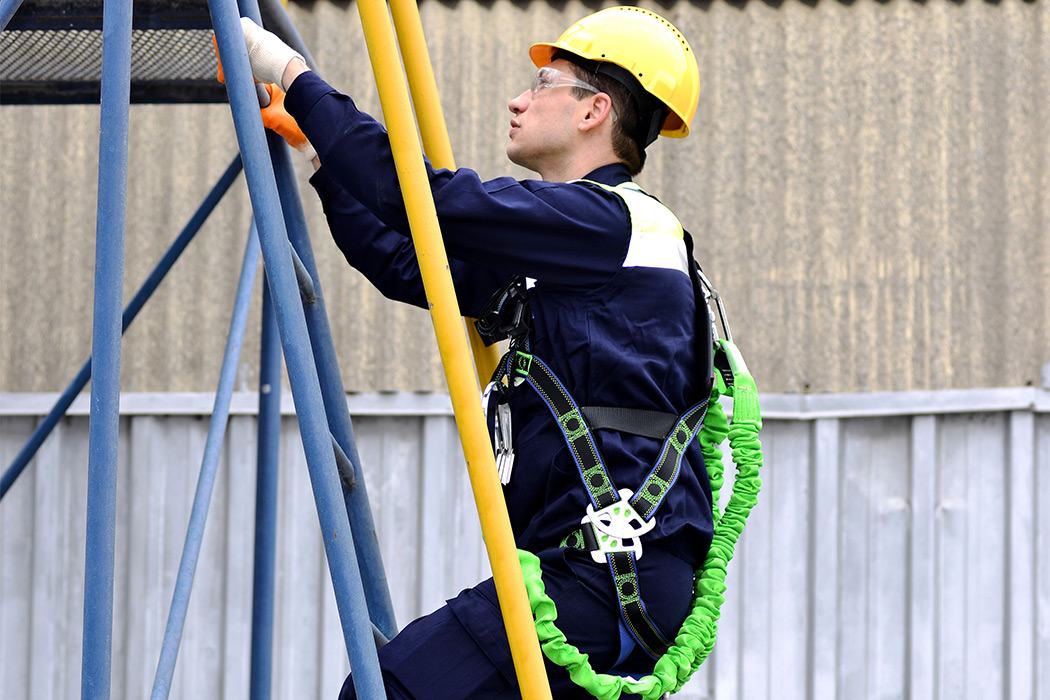
Personal Fall Protection
Written by: John Trevor
It’s no secret that falls are the leading cause of fatalities in the construction industry, even with all the new technology and personal fall protection that is available today. A Personal Fall Arrest System (PFAS) which usually consists of a full body harness, lanyard, and an anchorage point, is worn by a person who is exposed to a potential fall hazard, such as a leading edge. There is a lot more to just putting on a harness and going to work. The Occupational Safety and Health Administration (OSHA) as well as the manufacturer of the fall protection equipment that is being used, such as Miller, SafeWaze, and DBI Sala, have specific requirements that must be followed before fall protection can be worn. The complete OSHA regulations can be found in 29 CFR 1926 Subpart M-Fall Protection.
It is crucial that the user of fall protection equipment fully understands how to use it and the potential dangers if not used properly. In addition, it is the employer’s responsibility to ensure that all users are trained in the proper use, inspection, and maintenance of fall protection equipment. Fall protection training should be an integral part of a comprehensive safety program. Proper use of fall arrest systems can save lives and reduce the potential of serious injuries from a fall. The user must be aware that forces experienced during the arrest of a fall, or prolonged suspension, may cause bodily injury.
General Requirements of Fall Protection
Proper precautions should always be taken to remove any obstruction, debris, material, or other recognized hazards from the work area that could cause injuries, or interfere with the operating system. All equipment MUST be inspected by the wearer before each use, according to the manufacturer’s instructions, and all fall protection equipment should be inspected by a qualified person on a regular basis. Never remove any product labels. These labels include important warnings and information for the user. Check the information on your harness and lanyard about the maximum capacity. Equipment must not be altered in any way, and repairs must be performed only by the manufacturer or entities authorized by the manufacturer in writing.
Any product exhibiting deformities, unusual wear, or deterioration must be immediately taken out of service, and any equipment subjected to a fall must be removed from service as well. Never use fall protection equipment for purposes other than those for which it was designed, which means fall protection equipment should never be used for towing or hoisting. All synthetic material must be protected from slag, hot sparks, open flames, or other heat sources. Do not allow equipment to come in contact with anything that will damage it, including sharp, abrasive, or rough surfaces. Always check for obstructions below the work area to make sure potential fall path is clear. Allow adequate fall clearance distance below the work surface. Remember, if you are working 10’ off the ground and using a 6’ shock absorbing lanyard you will hit the ground before the fall protection deploys!
Three key components need to be in place and properly used to provide maximum worker protection.
-
ANCHOR POINT/CONNECTOR- The first component is the anchor point/connector. The anchor point, also referred to as the tie-off point, is a secure point of attachment for connecting devices and must be capable of supporting 5,000 lbs. per worker. Anchorage connectors, such as the cross arm strap, are sometimes necessary to make connections between the connecting device and the anchor point.
-
BODY WEAR- The second system component is the personal protective gear worn by workers while performing the job. Full body harnesses are engineered to aid in the arrest of a free fall and should be worn in all situations where workers are exposed to a potential fall. The full body harness must be used in conjunction with shock absorbing equipment to keep fall forces to a minimum. It is imperative that the harness be worn properly.
-
CONNECTING DEVICE- The third component of the system is the connecting device. The most important feature of the connecting device is the built in shock absorber. Whether the connecting device is a shock absorbing lanyard or a self- retracting lifeline, they are designed to dramatically reduce fall arresting forces. Fall protection lanyards can be made of steel, cable, rope, or nylon webbing.
Proper Harness Fit
It is extremely important that your harness fits properly and is properly adjusted. Failure to do so can result in serious injury or death, and proper connection of both types of straps is essential to fall safety. After donning (putting on) a harness, be sure to check:
CHEST STRAP– Should be positioned in the middle of your chest (below the trachea but not below the sternum). If the chest strap is positioned too high the strap may move upwards during a fall arrest causing you to run the risk of strangulation. If the chest strap is too low or not connected at all, you could fall out of your harness during a fall.
LEG STRAPS– Proper adjustment of the leg straps is critical for safety. Leg straps should be snug, but not snug to the point that they obstruct normal blood circulation in the legs. Failure to wear leg straps will not secure your body within the harness during a fall and could lead to serious injury or death.
SUB-PELVIC STRAP– Provides support in the event of a fall and also provides support when used for positioning. In a seated position the sub-pelvic strap should comfortably provide a “seat” for the buttocks. In the event of a fall lift up your legs to transfer weight to the sub-pelvic strap.
Cleaning and Storage
Basic care of fall protection equipment will prolong the life of the unit and will contribute toward the performance of its vital safety function. Proper storage and maintenance after use are just as important as cleansing the equipment of dirt, corrosives, or contaminants. Storage areas should be clean, dry, and free of exposure to fumes or corrosive elements. Wipe off all surface dirt with a sponge dampened in plain water and then wipe dry with a clean cloth. Hang freely to dry, but keep away from excessive heat, steam, or long periods of sunlight.
Life Expectancy of a Harness will vary from manufacturer to manufacturer, but as a general guideline, use a 5-year expectancy from the date of first use on all harness. This guideline only applies to product exhibiting no visual damage and has not been exposed to abnormal conditions. It is possible that the equipment will last longer depending on the care and use the equipment may see. Following these instructions may still necessitate removing the harness from service prior to the expiration of the 5-year life expectancy guideline. Ultimately, it is the responsibility of the end user to determine when the harness is unfit for use and should be removed from service. Products removed from service should be disposed of in a manner that prevents inadvertent further use.
Hopefully these instructions will give you a better understanding on how personal fall protection works, and what it is designed to do for you in the event of a fall.







My friend was telling me about fall protection equipment, and I decided to look a little deeper into it. I had no idea that you should store them in clean, dry, and free from exposure to fumes. I always thought that they would just store them where ever on the job site. Thank you for the information. http://publicworkssupply.com/product-category/fall-protection-equipment/